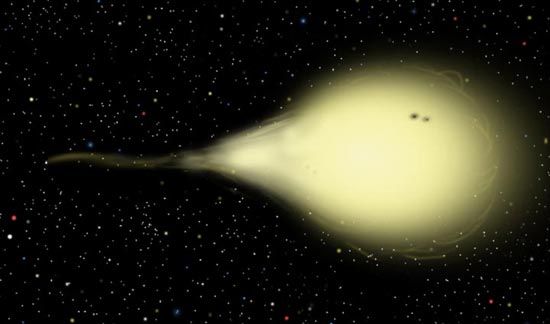Cosmic Limbo: Star Drained of Matter, Identity

It is not a planet. It is not a star. It isn't even a brown dwarf, the name astronomers usually give an object that is neither of the above. No, this strange ball of gas is no longer much of ... anything.
The faraway object used to be a star. But a companion sucked most of the matter from it, leaving a space corpse like nothing scientists have seen before.
As with all "new" things in space, this one is labeled a mystery, an object with an identity crisis of cosmic proportions.
Too close for comfort
Some 500 million years ago, the star burned bright, researchers said yesterday. But it snuggled too close to a much more massive object, a compact star called a white dwarf that is also in the twilight of its existence.
The two-object death dance is known as a binary system, called EF Eridanus. It is 300 light-years away.
The objects have always been close. They used to orbit one another every four or five hours. But the interaction brought them closer together over millions of years. Now their orbit is astonishingly rapid -- every 81 minutes.
Get the Space.com Newsletter
Breaking space news, the latest updates on rocket launches, skywatching events and more!
Both objects used to be similar to our Sun, astronomers say.
The white dwarf is now about 60 percent as massive as the Sun and has collapsed to a diameter about equal to that of Earth.
The mystery object now contains a mere 1/20th as much material as the Sun and is still inflated to roughly the same diameter as Jupiter, researchers said. (The Sun is 1,000 times as massive as Jupiter.)
Class by itself
The donor star -- when it was still a star -- just "gave, and gave, and gave some more until it had nothing left to give," said Steve Howell, an astronomer with Wisconsin-Indiana-Yale-NOAO (WIYN) telescope and the National Optical Astronomy Observatory.
"Now the donor star has reached a dead end," Howell said. "It is far too massive to be considered a super-planet, its composition does not match known brown dwarfs, and it is far too low in mass to be a star. There's no true category for an object in such limbo."
Astronomers don't know exactly when the donor star began losing mass, or why the process has stopped, as the new observations show. But Howell's team suspects the pair used to be farther apart. They're now as close as the Moon is to Earth.
The discovery will be detailed in the Oct. 20 issue of the Astrophysical Journal. The infrared observations were made primarily with the Gemini North telescope and Keck II, two huge telescopes on Mauna Kea in Hawaii.
The researchers are now looking at 15 other binary systems that might be similar to the strange setup they've just witnessed, with the hope of understanding the newfound object by association.
Join our Space Forums to keep talking space on the latest missions, night sky and more! And if you have a news tip, correction or comment, let us know at: community@space.com.

Rob has been producing internet content since the mid-1990s. He was a writer, editor and Director of Site Operations at Space.com starting in 1999. He served as Managing Editor of LiveScience since its launch in 2004. He then oversaw news operations for the Space.com's then-parent company TechMediaNetwork's growing suite of technology, science and business news sites. Prior to joining the company, Rob was an editor at The Star-Ledger in New Jersey. He has a journalism degree from Humboldt State University in California, is an author and also writes for Medium.